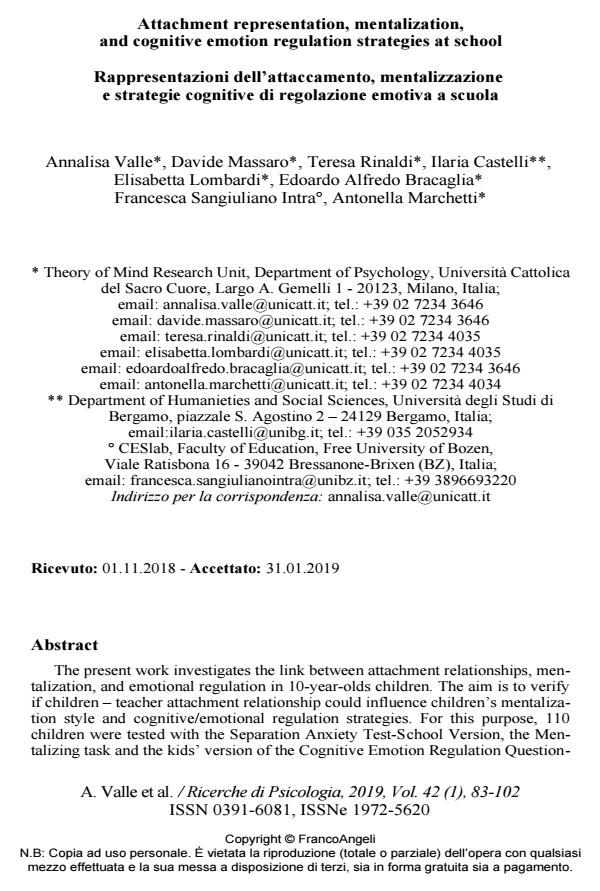Attachment representation, mentalization, and cognitive emotion regulation strategies at school
Journal title RICERCHE DI PSICOLOGIA
Author/s Annalisa Valle, Davide Massaro, Teresa Rinaldi, Ilaria Castelli, Elisabetta Lombardi, Edoardo Alfredo Bracaglia, Francesca Sangiuliano Intra, Antonella Marchetti
Publishing Year 2019 Issue 2019/1
Language English Pages 20 P. 83-102 File size 220 KB
DOI 10.3280/RIP2019-001006
DOI is like a bar code for intellectual property: to have more infomation
click here
Below, you can see the article first page
If you want to buy this article in PDF format, you can do it, following the instructions to buy download credits

FrancoAngeli is member of Publishers International Linking Association, Inc (PILA), a not-for-profit association which run the CrossRef service enabling links to and from online scholarly content.
The present work investigates the link between attachment relationships, mentalization, and emotional regulation in 10-year-olds children. The aim is to verify if children - teacher attachment relationship could influence children’s mentalization style and cognitive/emotional regulation strategies. For this pur-pose, 110 children were tested with the Separation Anxiety Test-School Version, the Mentalizing task and the kids’ version of the Cognitive Emotion Regulation Questionnaire. The results show that Self-Reliance component of the attachment representation with teacher predicts both the negative scale of mentalization and the propensity to use the emotional regulation strategy of "Positive Refocusing". Likewise, the Avoidance scale and the Total scale of the Separation Anxiety Test-School Version also influence the use of the cognitive emotion regulation strategy "Putting into Perspective" and of "Positive Refocusing,- respectively. Results are discussed within the theoretical framework of multiple attachment theory, con-firming the hypothesis that affective relationships with professional caregivers - namely school teachers - play an important role in constructing self-representation and the abilities to regulate emotions in stressful situations.
Keywords: Attachment, mentalization styles, emotion regulation, school, child-teacher relationship.
- The Mentalized Affectivity Scale (MAS): Development and validation of the Italian version Teresa Rinaldi, Ilaria Castelli, Andrea Greco, David M. Greenberg, Elliot Jurist, Annalisa Valle, Antonella Marchetti, Frantisek Sudzina, in PLOS ONE /2021 pp.e0249272
DOI: 10.1371/journal.pone.0249272 - Teacher-student attachment relationship, variables associated, and measurement: A systematic review Laura García-Rodríguez, Concha Iriarte Redín, Charo Reparaz Abaitua, in Educational Research Review 100488/2023 pp.100488
DOI: 10.1016/j.edurev.2022.100488 - Do educators matter? Associations between caregivers’ mentalization and preschoolers’ attachment, social emotional development and theory of mind Cecil Mata López, María Pía Santelices Álvarez, Alvaro Vergés Gómez, in Early Child Development and Care /2022 pp.233
DOI: 10.1080/03004430.2020.1755664 - The representation of child–parent relation: validation of the Italian version of the child–parent relationship scale (CPRS-I) Teresa Rinaldi, Ilaria Castelli, Nicola Palena, Andrea Greco, Robert Pianta, Antonella Marchetti, Annalisa Valle, in Frontiers in Psychology 1194644/2023
DOI: 10.3389/fpsyg.2023.1194644 - Mentalization and attachment in educational relationships at primary school Annalisa Valle, Teresa Rinaldi, Andrea Greco, Robert Pianta, Ilaria Castelli, Antonella Marchetti, in RICERCHE DI PSICOLOGIA 1/2022 pp.1
DOI: 10.3280/rip2022oa13226 - The Risk-Taking and Self-Harm Inventory for Adolescents: Validation of the Italian Version (RTSHIA-I) Annalisa Valle, Giulia Cavalli, Laura Miraglia, Edoardo Alfredo Bracaglia, Peter Fonagy, Cinzia Di Dio, Antonella Marchetti, in Behavioral Sciences /2023 pp.321
DOI: 10.3390/bs13040321 - Humanity in Psychology Antonella Marchetti, Edoardo Alfredo Bracaglia, pp.179 (ISBN:978-3-031-30639-6)
- Attachment, emotion regulation, and burnout among university students: a mediational hypothesis Hugo Marques, Rute Brites, Odete Nunes, João Hipólito, Tânia Brandão, in Educational Psychology /2023 pp.344
DOI: 10.1080/01443410.2023.2212889
Annalisa Valle, Davide Massaro, Teresa Rinaldi, Ilaria Castelli, Elisabetta Lombardi, Edoardo Alfredo Bracaglia, Francesca Sangiuliano Intra, Antonella Marchetti, Attachment representation, mentalization, and cognitive emotion regulation strategies at school in "RICERCHE DI PSICOLOGIA " 1/2019, pp 83-102, DOI: 10.3280/RIP2019-001006